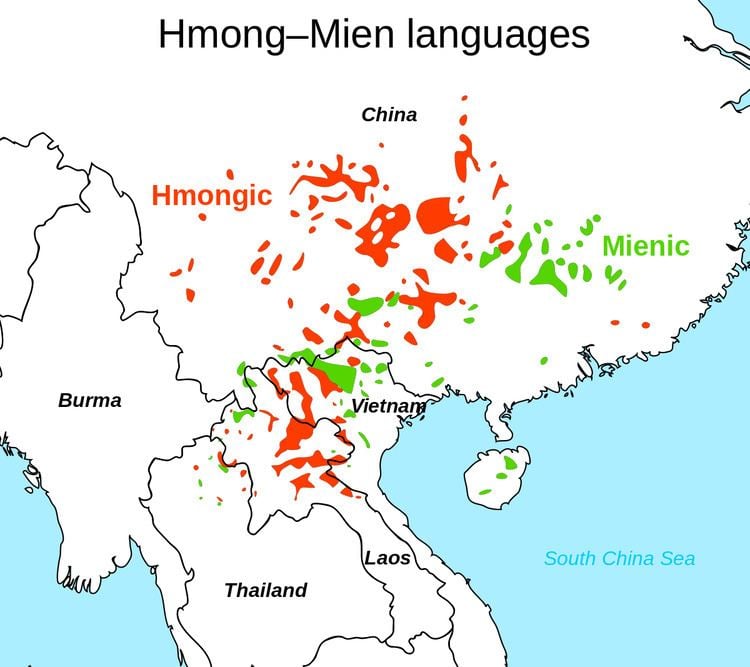 | ||
The Proto-Hmong–Mien language is the reconstructed ancestor of the Hmong–Mien languages. The time of proto-Hmong-Mien has been estimated to be about 2500 BP by Sagart, Blench, and Sanchez-Mazas and about 4243 BP by the Automated Similarity Judgment Program (ASJP). Lower-level reconstructions include Proto-Hmongic and Proto-Mienic.
Contents
Reconstructions
Past reconstructions include Wang & Mao (1995).
Ratliff (2010)
Ratliff (2010) used 11 criterion languages for her reconstruction.
- East Hmongic (Qiandong); Northern vernacular: Yanghao 养蒿, Yanghao Township, Taijiang County, Guizhou
- North Hmongic (Xiangxi); Western vernacular: Jiwei 吉卫, Jiwei Township, Huayuan County, Hunan
- West Hmongic (Chuanqiandian): White Hmong of Laos and Thailand
- West Hmongic (Chuanqiandian); Mashan subdialect, Central vernacular: Zongdi 宗地, Zongdi Township, Ziyun County, Guizhou
- West Hmongic (Chuanqiandian); Luopohe subdialect: Fuyuan 复员, Fuyuan County, Yunnan
- Hmongic; Jiongnai: Changdong Township 长垌, Jinxiu County, Guangxi
- Hmongic; Baiyun Pa-Hng: Baiyun 白云, Rongshui County, Guangxi
- Mienic; Mien, Luoxiang vernacular: Luoxiang Township 罗香, Jinxiu County, Guangxi
- Mienic; Mun: Lanjin Township 览金, Lingyun County, Guangxi
- Mienic; Biao Min: Dongshan Yao Township 东山, Quanzhou County, Guangxi
- Mienic; Zao Min: Daping Township 大平, Liannan County, Guangdong
Wang & Mao (1995)
Wang & Mao (1995) base their Proto-Hmong-Mien reconstruction from the following 23 criterion Hmong-Mien languages.
- Yanghao 养蒿; Hmu, North (ISO 693-3: [hea])
- Jiwei 吉卫; Qo Xiong, West [mmr]
- Xianjin 先进 ( = Dananshan 大南山); Chuanqiandian Miao, 1st lect [cqd]
- Shimenkan 石门坎; Diandongbei Miao [hmd]
- Qingyan 青岩; Guiyang Miao, North [huj]
- Gaopo 高坡; Huishui Miao, North [hmi]
- Zongdi 宗地; Mashan Miao, Central [hmm]
- Fuyuan 复员; Luopohe Miao, 2nd lect [hml]
- Fengxiang 枫香; Chong'anjiang Miao [hmj]
- Qibainong 七百弄; Bunu, Dongnu [bwx]
- Yaoli 瑶里; Nao Klao, Baonuo [bwx]
- Wenjie 文界; Pa-Hng, Sanjiang [pha]
- Changdong 长峒; Jiongnai [pnu]
- Duozhu 多祝; She [shx]
- Jiangdi 江底; Iu Mien, Guangdian [ium]
- Xiangjiang 湘江; Iu Mien, Xiangnan [ium]
- Luoxiang 罗香; Luoxiang Mien AKA Ao Biao [ium]
- Changping 长坪; Changping Mien AKA Biao Mon [ium]
- Liangzi 梁子; Kim Mun [mji]
- Lanjin 览金; Kim Mun [mji]
- Dongshan 东山; Biao Mon, Dongshan [bmt]
- Sanjiang 三江; Biao Mon, Shikou AKA Chao Kong Meng [bmt]
- Daping 大坪; Dzao Min [bpn]
Phonology
Martha Ratliff's 2010 reconstruction contains the following phonemic inventory.
Medial consonants are *-j-, *-l-, and *-r-.
Proto-Hmong–Mien had the following syllable structure (Ratliff 2010:10):
(C) C [j/w/l] [i̯/u̯] (V) V C (C)T
Ratliff does not reconstruct vowel length for either Proto-Mienic or Proto-Hmong-Mien. Even though Mienic languages usually have vowel length, Ratliff ascribes this to areal features that were borrowed after the breakup of Proto-Mienic. Neighboring languages with vowel length include Cantonese and Zhuang.
Vocabulary
Below are some reconstructed words roughly belonging to the semantic domains of agriculture and subsistence (Ratliff 2004; Greenhill et al. 2008; Starling 1998). Terms for domesticated animals and non-rice crops are usually shared with Chinese, while vocabulary relating hunting, rice crops, and local plants and animals are usually not shared with Chinese.
